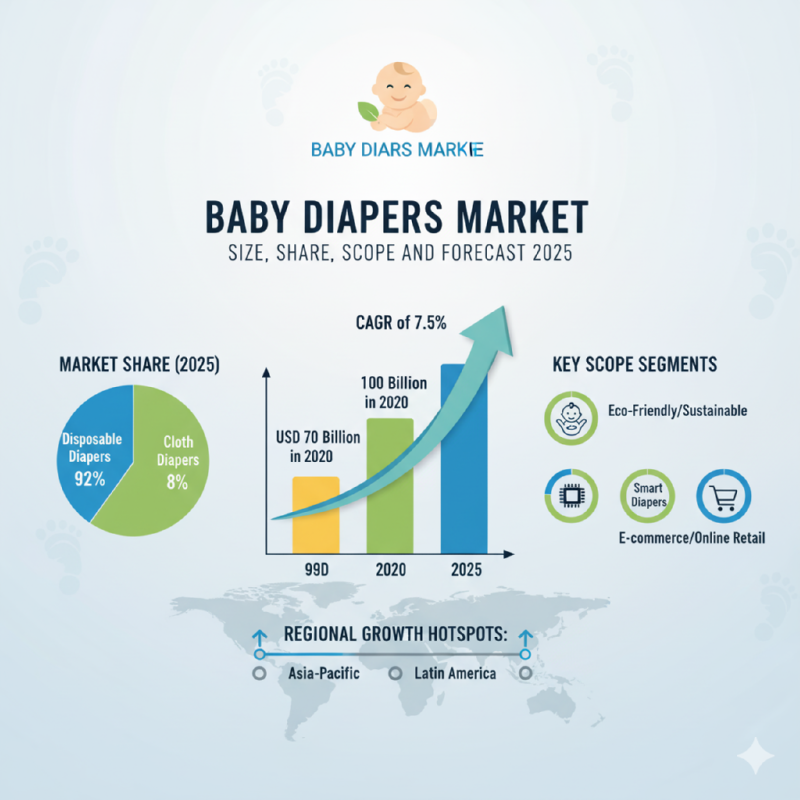Baby Diapers Market Size, Share, Scope And Forecast 2025
페이지 정보

본문

The Baby Diapers Market comprises the entire ecosystem surrounding absorbent hygiene products designed for infants and toddlers who are not yet toilet-trained. Defined by core components like the highly efficient Super Absorbent Polymer ( SAP ) and breathable non-woven fabrics, the market's primary objective is to deliver optimal comfort, leakage protection, and skin health. While the traditional cloth or reusable diaper segment persists, the global market is overwhelmingly dominated by the disposable category due to its unmatched convenience and superior performance. The market acts as a fundamental indicator of global demographic trends and consumer spending habits within the essential baby care sector.
Get Sample Report:
https://www.marketresearchupdate.com/sample/428492
Baby Diapers Market Overview
The Baby Diapers Market is currently a high-value global industry characterized by resilient growth and dynamic internal shifts. Overall market trajectory is steered by two primary forces: volume expansion in emerging economies, driven by population size and rising income, and value growth (premiumization) in developed nations, where penetration is already high. Key trends include the shift toward pant-style diapers for ease of use and a significant industry-wide pivot toward sustainability . Manufacturers are consistently enhancing product design, focusing on thinness, fit, and the incorporation of natural, skin-friendly materials to maintain a competitive edge.
Get Discount:
https://www.marketresearchupdate.com/discount/428492
Baby Diapers Market Drivers
Several influential factors are actively driving the growth of the Baby Diapers Market . The most significant driver is the rising rate of urbanization and the resulting increase in working women globally, creating a high demand for convenient, time-saving disposable solutions. This lifestyle shift makes daily laundering of cloth diapers impractical for many urban families. Furthermore, consistent increases in disposable income in developing regions enable parents to transition from low-cost alternatives to branded, high-performance disposable diapers. Coupled with rising global awareness of infant health, parents are increasingly willing to pay a premium for products with superior skin protection and hygiene features.
Baby Diapers Market Restraints
Despite strong demand, the Baby Diapers Market faces critical restraints that challenge profitability and sustainability. The most substantial hurdle is the environmental impact caused by the disposal of billions of non-biodegradable diapers, which contributes heavily to landfill waste and drives stricter regulatory scrutiny. This forces manufacturers to invest heavily in costly R&D for sustainable alternatives. Additionally, volatility in the price of key raw materials—including petroleum-based polymers and fluff pulp—puts constant pressure on manufacturing margins. Finally, the high cost of premium, high-absorption diapers remains a significant restraint, limiting broad-based market adoption among low-income consumers globally.
Baby Diapers Market Opportunities
Significant opportunities for future growth within the Baby Diapers Market are concentrated in technological and material innovation. The largest potential lies in the successful commercialization of fully biodegradable and compostable diaper solutions, which would resolve the industry's largest environmental challenge and capture the rapidly growing eco-conscious consumer base. A second major opportunity involves the integration of "smart" technology, such as moisture-detection sensors and data-transmitting chips, that provide real-time parental alerts and potential health monitoring capabilities. Furthermore, market expansion into specialized segments, such as highly targeted training pants for older toddlers and niche products for sensitive skin, offers avenues for premium value creation.
Baby Diapers Market Key Players
The competitive landscape of the Baby Diapers Market is characterized by the dominance of a few powerful multinational corporations, known as the Key Players. These include Procter & Gamble (P&G) (Pampers), Kimberly-Clark (K-C) (Huggies), and Unicharm Corporation (MamyPoko), a leading entity in the Asian market. These companies maintain their market leadership through massive scale, vast and efficient distribution networks, and continuous investment in product superiority and brand loyalty. Competition often centers on aggressive pricing, sophisticated marketing campaigns, and strategic acquisitions of smaller, regional, or niche sustainable brands to diversify their technological footprint.
Baby Diapers Market Segmentation
The Baby Diapers Market is segmented across multiple criteria to address specific consumer needs and purchasing behaviors. By Product Type , the market is divided into disposable diapers (the dominant segment), cloth/reusable diapers, and training pants (the fastest-growing category due to its transitional function). By Distribution Channel , the primary segments are Supermarkets/Hypermarkets, which handle the largest volume, and Online Retail , which is growing fastest due to the convenience of bulk purchasing and subscription models. Crucial segmentation also occurs By Size and Age Group , ensuring that products are optimally tailored for fit and absorbency across various stages, from newborn to junior sizes.
B aby Diapers Market Regional Analysis
Geographically, the Baby Diapers Market displays distinct maturity patterns. Asia-Pacific (APAC) represents the highest-growth region, driven by its large population base, high birth rates, and accelerating economic development, which facilitates the shift from cloth to disposable products. North America and Europe, in contrast, are mature and highly saturated markets where growth is concentrated on value-added products —premium features, customization, and sustainable/organic materials. Latin America and the Middle East & Africa (MEA) are regarded as emerging markets offering long-term volume potential, constrained only by the need for better distribution infrastructure and lower consumer disposable income levels.
Baby Diapers Market Recent Developments
Recent developments in the Baby Diapers Market reflect a strong industry response to consumer and environmental demands. A key trend is the rapid increase in product launches focused on material reformulation , including the introduction of diapers with a higher percentage of plant-based materials, biodegradable back sheets, and reduced chemical additives. Furthermore, the pant-style/pull-up segment has seen significant investment, with innovations focused on improved elasticity and absorption for active toddlers. Strategically, manufacturers are engaging in frequent mergers, acquisitions, and partnerships to secure specialized technology, especially in the absorbent core and sustainable packaging domains.
Get Full Access to Report:
https://www.marketresearchupdate.com/industry-growth/north-america-baby-diapers-market-428492
#BabyDiapersGrowth #AbsorbentHygiene #CPGAnalysi
댓글목록
no comments.